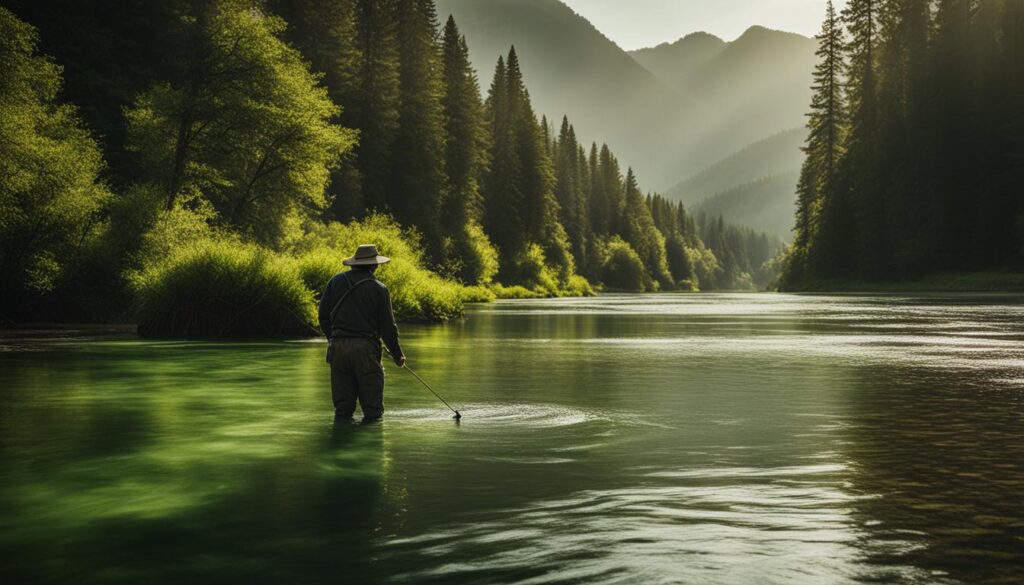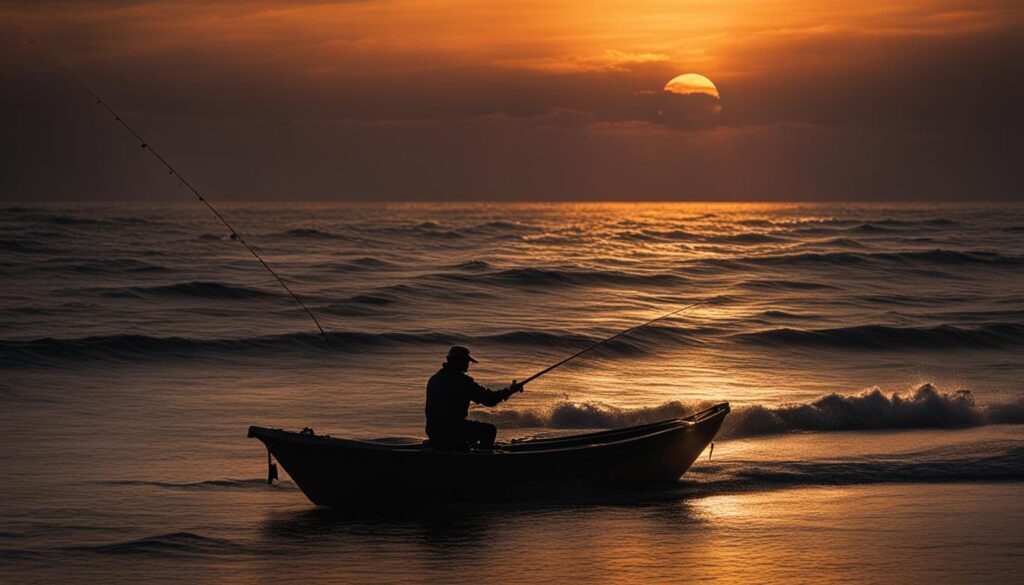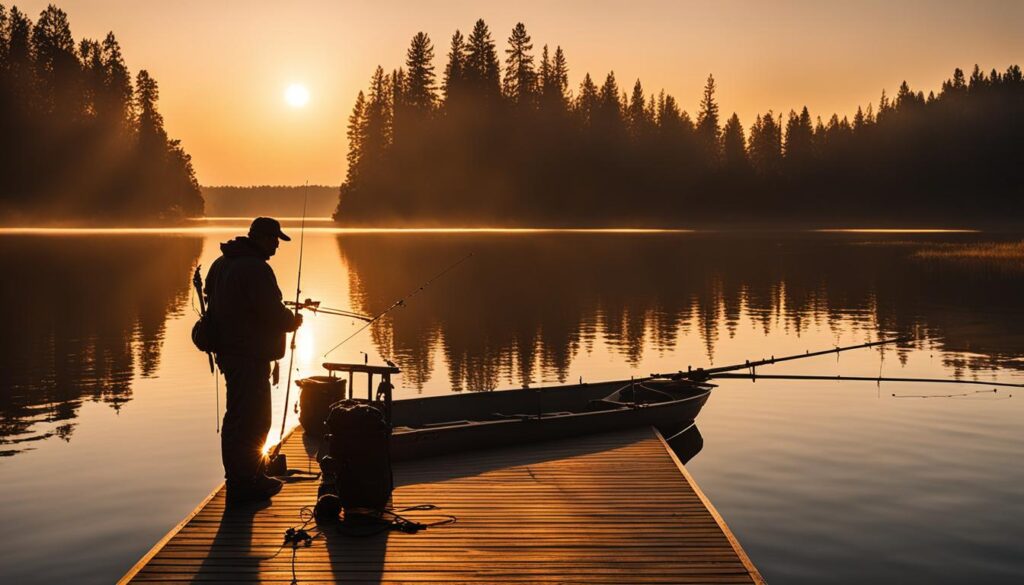We may earn money or products from the companies mentioned in this post.
If you’re an angler looking to enhance your freshwater fishing skills, you’re in the right place. In this article, we will explore various techniques that will help you improve your cast, reel in bigger fish, and experience the thrill of freshwater fishing.
Freshwater fishing is a popular pastime for many anglers, and there’s nothing quite like the excitement of casting your line and feeling the tug of a fish on the other end. Whether you’re a beginner or an experienced angler, there’s always room for improvement.
Key Takeaways
- Various freshwater fishing techniques can help you improve your angling skills.
- Mastering your cast and selecting the right lures and baits are crucial for successful freshwater fishing.
- Understanding fish behavior and adapting your techniques to different fishing environments can increase your chances of a successful catch.
- Properly tying fishing knots is essential for a secure and reliable connection between your line and your lure or bait.
- Fishing in ponds offers unique challenges and opportunities, and specific techniques can increase your chances of catching fish in these smaller bodies of water.
Bass Fishing Techniques for a Successful Catch
Catching bass can be challenging, but with the right techniques, you can increase your chances of a successful catch. Here are some effective bass fishing techniques:
Selecting the Right Lures and Baits
One of the essential bass fishing techniques is selecting the right lures and baits. Different lures and baits work differently in different situations, so it’s crucial to choose the right one. Some of the popular lure and bait options for bass fishing include:
| Lures | Baits |
|---|---|
| Jigs | Crayfish |
| Crankbaits | Worms |
| Spinners | Minnows |
When selecting lures and baits, consider the water conditions, time of day, and the behavior of the bass. For example, if the water is clear, use natural-colored lures and baits. If the water is muddy, use bright-colored lures and baits to attract the fish’s attention.
Understanding Bass Behavior
To catch bass, it’s essential to understand their behavior. Bass tend to move in patterns and seek out specific types of cover. Some of the common types of cover that bass use include weed beds, rocks, and fallen trees.
When fishing for bass, take note of the cover in the area and cast your lure or bait near it. Bass will often hide in these areas, waiting for prey to swim by. If you can get your lure or bait close to the cover, you’ll increase your chances of a strike.
Retrieving Your Lure or Bait
Retrieving your lure or bait in the right way is crucial for catching bass. Different retrieves work better in different situations, so it’s essential to experiment to find what works for you. Some common retrieval techniques include:
- Slow retrieve: This technique involves slowly reeling in your lure or bait, which works well in colder water or when the bass are less active.
- Stop-and-go retrieve: This technique involves reeling in your lure or bait for a few seconds, then pausing for a few seconds before continuing. It works well when the bass are following your lure but not taking it.
- Fast retrieve: This technique involves quickly reeling in your lure or bait, which works well when the bass are actively feeding or when the water is warmer.
Try different retrieval techniques to see what works best for the conditions you’re fishing in.
By implementing these bass fishing techniques, you can increase your chances of a successful catch. Remember to be patient, experiment, and enjoy the thrill of the catch.
Trout Fishing Tips for a Rewarding Experience
If you’re looking for a rewarding fishing experience, targeting trout in freshwater can be a great option. Whether you’re a seasoned angler or just getting started, these trout fishing tips can help increase your chances of success:
1. Choose the Right Bait or Lure
Trout have a diverse diet, so it’s important to choose the right bait or lure for the conditions you’re fishing in. Some popular options include:
| Bait/Lure | When to Use |
|---|---|
| Live bait (worms, minnows) | In slower-moving water, when fish are less active |
| Artificial lures (spinners, spoons) | In faster-moving water, when fish are more active |
| Fly fishing gear (dry flies, nymphs) | In clear water or when fish are feeding on the surface |
2. Adjust Your Technique Based on Water Temperature
Trout are cold-water fish, so their behavior can vary depending on the temperature of the water. In warmer water, they may be less active and feed less frequently. Try adjusting your technique by:
- Fishing in deeper water
- Using smaller baits or lures
- Fishing in the early morning or late evening when the water is cooler
3. Pay Attention to Your Surroundings
To successfully target trout, it’s important to pay attention to your surroundings and use this information to adjust your approach. Some things to consider include:
- The color of the water and how clear it is
- The type of vegetation or rocks present
- Any signs of activity (jumping fish, ripples on the surface)
4. Practice Proper Catch and Release Techniques
Trout are a popular game fish, and it’s important to practice proper catch and release techniques to ensure their survival. These techniques include:
- Using barbless hooks to minimize injury to the fish
- Keeping the fish in the water as much as possible
- Handling the fish gently and not squeezing it too tightly
With these trout fishing tips in mind, you’ll be well on your way to a rewarding and successful fishing experience.
Best Lures for Freshwater Fishing: Enhancing Your Success
Choosing the right lure is crucial for successful freshwater fishing. With so many lures available on the market, it can be overwhelming to decide which ones to use. In this section, we’ll guide you through some of the best lures for freshwater fishing that will increase your chances of catching your next big fish.
Jigs
Jigs are versatile lures that can be used in various freshwater environments. They are especially effective for catching bass and walleye. Jigs come in different shapes, sizes, and colors, allowing you to customize your lure to the specific fish species you’re targeting. They work well in both shallow and deep waters and can be used in various fishing techniques, including pitching, flipping, and casting.
Spinnerbaits
Spinnerbaits are excellent lures for catching bass, pike, and musky. They have a spinning blade that creates vibration and flash, attracting fish from a distance. Spinnerbaits are versatile and can be used in different water conditions, including clear and murky waters. They come in various sizes, colors, and blade shapes, allowing you to tailor your lure to the specific fish species you’re targeting.
Crankbaits
Crankbaits are popular lures for catching bass, walleye, and pike. They are designed to mimic the movement of a swimming fish and come in different shapes, sizes, and colors. Crankbaits work well in both shallow and deep waters and can be used in various fishing techniques, including trolling and casting. They typically have a diving lip that allows them to dive to specific depths, making them effective in targeting fish that are feeding at different levels.
Topwater Lures
Topwater lures are exciting to use and can be effective for catching bass, pike, and musky. They float on the water’s surface and create a commotion that attracts fish from below. Topwater lures come in different shapes, sizes, and colors, and can be used in various fishing techniques, including walking the dog and popping. They work best in shallow waters and can be used in different types of cover, including weeds and lily pads.
Soft Plastic Baits
Soft plastic baits come in various forms, including worms, grubs, and crawfish. They are versatile lures that can be used for catching various freshwater fish species. Soft plastic baits are designed to mimic the movement of different types of prey, making them effective in tricking fish into biting. They come in different sizes, colors, and shapes, and can be used in different fishing techniques, including Texas rigging and Carolina rigging.
Choosing the right lure can make a significant difference in your freshwater fishing experience. Experiment with different types of lures and find the ones that work best for your fishing style and the species you’re targeting. Remember to have fun and enjoy the thrill of catching your next big fish!
Fishing Knots for Beginners: Essential Skills
Properly tying fishing knots is an essential skill for any angler, especially beginners. Ensuring a secure and reliable connection between your line and your lure or bait can be the difference between a successful catch or losing the fish. Here are some basic fishing knots every beginner angler should know:
- The Improved Clinch Knot: This is a popular knot for tying on lures or hooks with an eye. Start by passing the end of the line through the eye of the hook, then make five to seven wraps around the line with the tag end, passing the tag end back through the loop above the eye. Finally, moisten the knot and pull both the tag end and standing line to tighten.
- The Palomar Knot: Another popular knot for securing lures or hooks with an eye. Double about six inches of line and pass it through the eye of the hook, then tie a simple overhand knot in the doubled line, leaving a loop large enough to pass the lure or hook through. Finally, pass the hook or lure through the loop and pull both the standing line and the tag end to tighten the knot.
- The Blood Knot: This knot is great for joining two lines of similar diameter. Begin by overlapping the two lines for about six inches, then wrap the tag end of the first line around the second line five to seven times. Repeat the process with the other line, wrapping it around the first line in the opposite direction. Finally, pull both standing lines in opposite directions to tighten the knot, and trim both tag ends.
- The Surgeon’s Knot: This knot is ideal for joining two lines of different diameters. Start by overlapping the two lines for about six inches, then tie a simple overhand knot, passing both lines through the loop twice. Finally, moisten the knot and pull both standing lines to tighten.
With these basic knots in your repertoire, you can feel confident in your ability to securely tie on lures or hooks, and increase your chances of a successful catch. Remember to practice and master these knots before your next fishing trip, and you’ll be well on your way to becoming an expert angler.
Catching Fish in Ponds: Techniques for Success
Fishing in ponds requires different techniques than fishing in larger bodies of water like lakes and rivers. The confined space and limited fish population require specific strategies to increase your chances of catching fish. Here are some tips to help you succeed:
- Focus on the structure: Ponds often have natural or man-made structures like rocks, logs, and weed beds that attract fish. Try to cast your line near these structures to increase your chances of finding fish.
- Use smaller lures: In ponds, the fish are typically smaller and have less space to move around. Using smaller lures can be more effective in catching these fish. Try using small jigs or spinners to attract their attention.
- Change up your techniques: If you aren’t having any luck with one technique, try something different. Vary your retrieval speed, use different lures, or try a different location in the pond.
- Fish at the right time of day: Ponds are usually fished early in the morning or late in the afternoon when the fish are most active. However, it’s also important to consider the weather conditions, as sunny and clear days may cause the fish to be more hesitant to bite.
When fishing in ponds, it’s also essential to be aware of any regulations and restrictions in the area. Some ponds may have specific rules regarding types of bait and lures, and others may require permits or have catch limits.
| Fish Species | Best Time to Catch | Preferred Bait/Lure |
|---|---|---|
| Bass | Early morning or late afternoon | Spinnerbaits or plastic worms |
| Bluegill/Sunfish | Anytime during the day | Worms or small jigs |
| Trout | Early morning or late afternoon | Spinners or small spoons |
Tip: If you’re fishing in a pond that you’re unfamiliar with, try talking to locals or other anglers who have fished there before. They may have valuable insights and tips to share.
By understanding the unique challenges and opportunities of pond fishing, you can improve your chances of catching fish and have a rewarding fishing experience.
Conclusion
By implementing the various freshwater fishing techniques we’ve explored here, you can improve your angling skills and increase your chances of catching fish. Remember to always select the right lure or bait for the species you’re targeting, understand the behavior of the fish you’re trying to catch, and use the proper fishing knots to secure your line.
Don’t forget to practice often, and be patient. The more time you spend fishing, the more experience you’ll gain and the better you’ll become at anticipating the movements of fish. Whether you’re fishing in a pond or a lake, freshwater fishing offers endless opportunities for excitement and adventure.
Now that you’ve learned some of the essential freshwater fishing techniques, it’s time to hit the water and start catching some fish!
FAQ
How can freshwater fishing techniques enhance my angling skills?
Freshwater fishing techniques can help you improve your casting accuracy, increase your chances of catching fish, and enhance your overall angling experience. By utilizing different techniques such as understanding fish behavior, selecting the right lures or baits, and mastering fishing knots, you can become a more skilled angler.
What are some effective bass fishing techniques?
When it comes to bass fishing, some effective techniques include using topwater lures, flipping and pitching, and understanding bass behavior patterns. By employing these techniques, you can increase your chances of a successful catch and have an enjoyable bass fishing experience.
What tips and techniques can I use to catch trout in freshwater?
To catch trout in freshwater, it’s important to use the right bait or lures, understand trout behavior, and adapt your fishing strategies accordingly. Techniques such as drift fishing, fly fishing, and using natural baits can significantly improve your chances of landing trout.
What are the best lures for freshwater fishing?
The best lures for freshwater fishing vary depending on the target species. Some popular options include crankbaits, spinnerbaits, soft plastic worms, and jigs. It’s essential to consider the fish species you are targeting and the fishing conditions to select the most effective lure.
What are some essential fishing knots for beginners?
For beginners, some essential fishing knots include the improved clinch knot, the Palomar knot, and the uni knot. These knots are relatively easy to tie and provide strong and reliable connections between your line and your lure or bait.
What techniques can I use to catch fish in ponds?
When fishing in ponds, it’s important to adapt your techniques to the specific conditions. Some effective techniques include using smaller lures, targeting areas with structure, and adjusting your retrieval speed. By understanding the habits of fish in ponds, you can increase your chances of success.
Affiliate Disclosure: This post may contain affiliate links. If you purchase through our link, we may receive a small commission, but at no additional cost to you. For more information, please see our Disclosure statement.



